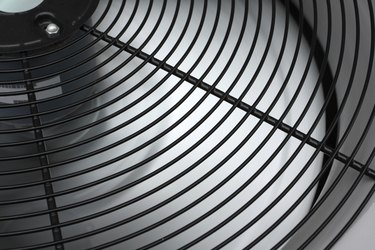
Evaporators are part of cooling systems found in air conditioners, refrigerators and freezers, and none of these would be able to cool air without them. They are coils located inside these units, and they cool the refrigerant that then comes out of the vents. When an evaporator isn't working, it can cause the whole cooling system to break down, leading to severe problems throughout the house, like mold or cracked and warped furniture.
How Evaporators Work
Video of the Day
Air conditioners are made of two primary parts. The inside unit is an air filter, evaporator core, evaporator coil and blower fan. Their outer parts have the compressor and condenser coil. The evaporator and condenser coils are made from copper tubing in most cases, and they twist around and are surrounded by aluminum fins. Refrigerant, a chemical coolant, flows between these two units. This coolant absorbs heat from the interior of the home and pushes it outside.
Video of the Day
Evaporator coils cool the refrigerant, and when the unit's fan blows air over it, that refrigerant gets cold and turns into vapor. Then, the refrigerant absorbs heat and flows to the outside. Here it becomes compressed and pressurized to become hot gas. Cold air goes into the home through the vents. With refrigerators and freezers, that cold air stays inside the appliances, and every time the doors are opened, cold air gets out.
Types of Evaporators
While many kinds of evaporators exist, there are two main kinds of evaporators that most people use: natural convection and forced convection. With the first kind, the refrigerant flows naturally to the evaporator because of the differences in density between the warm and chilled liquid. In the case of forced convection evaporators, these types of evaporators use pumps or fans to perform the process. These force the refrigerant over the evaporators.
As for evaporator construction, they can be made with a bare tube and plate surface or finned. Bare tube and plate surface evaporators have their whole surfaces contacting the evaporating refrigerant. With finned construction, you have bare tube coils with fins installed to increase your heat transfer capability. It is vital to have good thermal contact between the tubes and fins for efficient heat transfer. If there isn't good thermal contact, your evaporator will be much less effective than it could be.
Symptoms of Damaged Evaporators
One of the most evident symptoms of a damaged or broken evaporator is when the air blowing out is not cold enough or not cold at all. This loss of cooling can happen when evaporators leak, which can occur between the core and coil. If the compressor will not turn on and there is no air coming out, this could also be due to problems with the evaporator. Without sufficient pressure, the unit will not work.
An air conditioner can still work with an evaporator leak, but the temperature might vary and not stay at the set number. Another symptom is a strange odor seeping out of the seals, fins or coils. This smell may be somewhat sweet when the unit is off and can get stronger when you turn on the AC.
When refrigerators stop working, the culprit is often a damaged or broken compressor. If that is working and the fridge isn't cooling, it could be the evaporator. These can get coated with ice, which prevents their coils from working. These evaporators are located behind a panel at the back of the freezer; if you open the panel and see that its coils are covered with ice, you will need to defrost the freezer. If the refrigerator isn't cooling correctly and makes squealing noises, you might need to replace the evaporator fan.